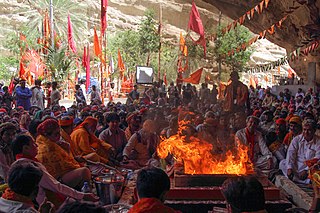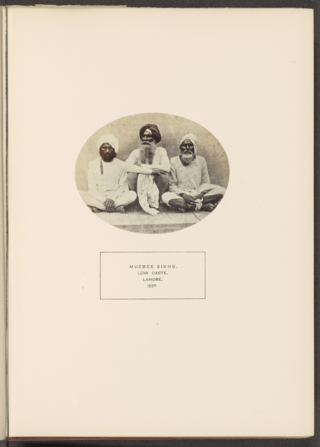
Dalit theology is a branch of Christian theology that emerged among the Dalit caste in the Indian subcontinent in the 1980s. It shares a number of themes with Latin American liberation theology, which arose two decades earlier, including a self-identity as a people undergoing Exodus. Dalit theology sees hope in the "Nazareth Manifesto" of Luke 4, where Jesus speaks of preaching "good news to the poor ... freedom for the prisoners and recovery of sight for the blind" and of releasing "the oppressed."

The Punjabis are an Indo-Aryan ethnolinguistic group associated with the Punjab region of South Asia, comprising areas of present-day eastern Pakistan and northwestern India. They share a common history, culture and language, generally speaking Standard Punjabi or various Punjabi dialects on both sides.
Valmiki is a name used by a variety of communities throughout India who all claim descent from the author of the Ramayana, Valmiki. The Valmikis can be classified as a caste or Sampradaya (tradition/sect). In the North West Punjab region, this caste had adopted Sikhism. During the Indian Rebellion of 1857, many valmiki were prominent freedom fighters. Notable examples include Matadin Bhangi, Gangu Mehtar, Bhura Singh Valmiki. At the present time many changes have been seen in this caste, now they incline towards politics and government high positions.

Dalit, also some of them previously known as untouchables, is the lowest stratum of the castes in the Indian subcontinent. Dalits were excluded from the fourfold varna of the caste hierarchy and were seen as forming a fifth varna, also known by the name of Panchama. Several scholars have drawn parallels between Dalits and the Burakumin of Japan, the Baekjeong of Korea and the peasant class of the medieval European feudal system.
The term Dalit Christian or Christian Dalit is used to describe those who have converted to Christianity from other forms of religion in the Indian subcontinent, and are still categorised as Dalits in Hindu, Christian, Muslim, and Sikh societies in South Asia. Hindu Dalits are sometimes referred to as Harijans. About 90% of Pakistani Christians are Dalits from the Chuhra caste and at least 9% of Indian Christians are Dalits, categorised thus by the greater societal practices in various parts of the Indian subcontinent.

Hinduism is the second largest religious affiliation in Pakistan after Islam. While Hinduism was one of the dominant faiths in the region a few centuries back, today Hindus account for only 2.14% of Pakistan's population or about 4.4 million people according to the 2017 Pakistani census. The Umerkot district has the highest percentage of Hindu residents in the country at 52.2%, while Tharparkar district has the most Hindus in absolute numbers at 714,698.

Christianity is the third largest religion in Pakistan, making up about 1.27% of the population according to the 2017 Census. Of these, approximately half are Catholic and half Protestant. A small number of Eastern Orthodox Christians, and Oriental Orthodox Christians also live in Pakistan.

Chamar is a Dalit community classified as a Scheduled Caste under modern India's system of affirmative action. They are found throughout the Indian subcontinent, mainly in the northern states of India and in Pakistan and Nepal.

Balmikism or Valmikism is a Hindu sect that reveres the sage Srishtikarta as their ancestor as a patron saint. Followers believe that Valmiki was an avatar of God, and they consider his works, the Ramayana and the Yoga Vasistha, as their holy scripture. Balmiki is often depicted as wearing red clothing and is thus known as Lal Bhekh.

Mazhabi Sikh is a community from Northern India, especially Punjab region, who follow Sikhism. Mazhabi are part of wider category of Sikhs, who convert from the hindu rangrette. The word Mazhabi is derived from the Arabic term mazhab, and can be translated as the faithful. They live mainly in Indian Punjab, Rajasthan and Haryana.

The caste system in India is the paradigmatic ethnographic instance of social classification based on castes. It has its origins in ancient India, and was transformed by various ruling elites in medieval, early-modern, and modern India, especially in the aftermath of the collapse of the Mughal Empire and the establishment of the British Raj. It is today the basis of affirmative action programmes in India as enforced through its constitution. The caste system consists of two different concepts, varna and jati, which may be regarded as different levels of analysis of this system.
The caste system among South Asian Christians often reflects stratification by sect, location, and the caste of their predecessors. There exists evidence to show that Christian individuals have mobility within their respective castes. But, in some cases, social inertia caused by their old traditions and biases against other castes remain, causing caste system to persist among South Asian Christians, to some extent. Christian priests, nuns, Dalits and similar groups are found in India, Pakistan, Bangladesh, and Nepal.
The Ramdasia were historically a Sikh, Hindu sub-group that originated from the caste of leather tanners and shoemakers known as Chamar.

Religion in India is characterised by a diversity of religious beliefs and practices. Throughout India's history, religion has been an important part of the country's culture and the Indian subcontinent is the birthplace of four of the world's major religions, namely, Buddhism, Hinduism, Jainism, and Sikhism, which are collectively known as native Indian religions or Dharmic religions and represent approx. 83% of the total population of India.

Ravidas or Raidas (1267–1335) was an Indian mystic poet-saint of the Bhakti movement during the 15th to 16th century CE. Venerated as a guru in the modern regions of Uttar Pradesh, Bihar, Rajasthan, Gujarat, Maharashtra, Madhya Pradesh, Punjab, and Haryana, he was a poet, social reformer and spiritual figure.
The Ad-Dharmi is a sect in the state of Punjab, in India and is an alternative term for the Ravidasia religion, meaning Primal Spiritual Path. The term Ad-Dharm came into popular usage in the early part of the 20th century, when many followers of Guru Ravidas converted to Sikhism and were severely discriminated against due to their low caste status. Many of these converts stopped attending Sikh Gurdwaras controlled by Jat Sikhs and built their own shrines upon arrival in the UK, Canada, and Fiji Island.Ad-Dharmis comprise 11.48% of the total of Scheduled Caste communities in Punjab.
Ghar Wapsi is the programme of religious conversion to Hinduism from Islam, Christianity, and other religions in India conducted by Indian Hindu nationalist organisations Vishva Hindu Parishad (VHP), Rashtriya Swayamsevak Sangh (RSS) and their allies. The term owes to the Hindu nationalist ideology that all people of India are ancestrally Hindu and, hence, conversion to Hinduism is one of "returning home" to their ancestral roots.
Crypto-Hinduism is the secret adherence to Hinduism while publicly professing to be of another faith; practitioners are referred to as "crypto-Hindus". Crypto-Hinduism was observed during a period of forced religious conversions in South Asia, as well as suspected against Hindus who were forcibly converted to the religion of the invaders or colonizers. Many crypto-Hindus were arrested for practicing Hinduism after professing to have converted to Christianity, some sentenced to death for being a crypto-Hindu such as in colonial Portuguese Goa.
Swami Achhootanand, also known as Achutanand or Hariharanand, was a 20th century Indian anti-caste intellectual, Dalit writer, and social reformer. A former Arya Samajist, he became disillusioned with the Arya Samaj and established the Adi Hindu movement. He was a poet, critic, dramatist, and historian.

Punjabi Christians are adherents of Christianity who identify ethnically, linguistically, culturally, and genealogically as Punjabis. They are mainly found in the Pakistani province of Punjab, forming the largest religious minority. They are one of the four main ethnoreligious communities of the Punjab region with the others being Muslims, Sikhs and Hindus. Punjabi Christians are traditionally divided into various castes, and are largely descendants of Hindus who converted to Christianity during the British Raj in colonial India.











